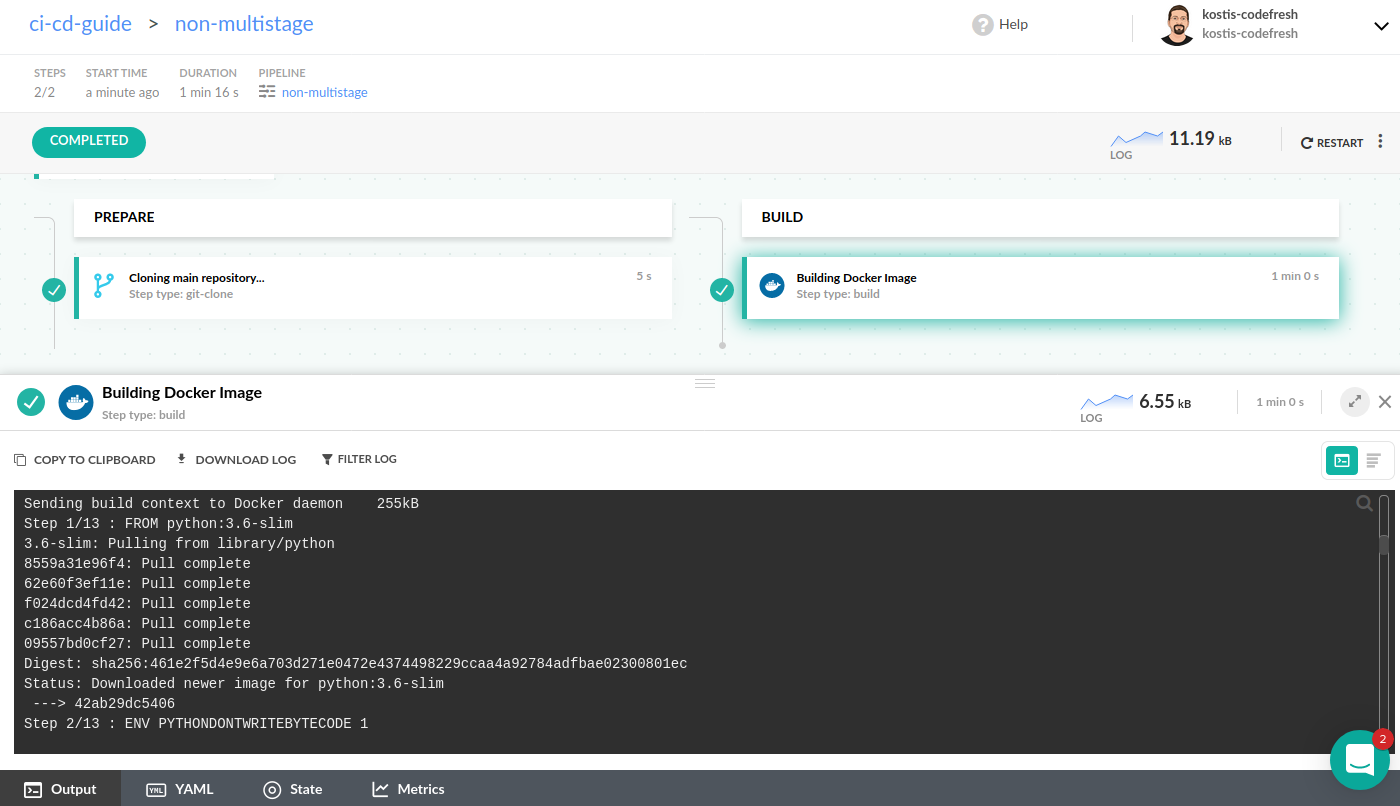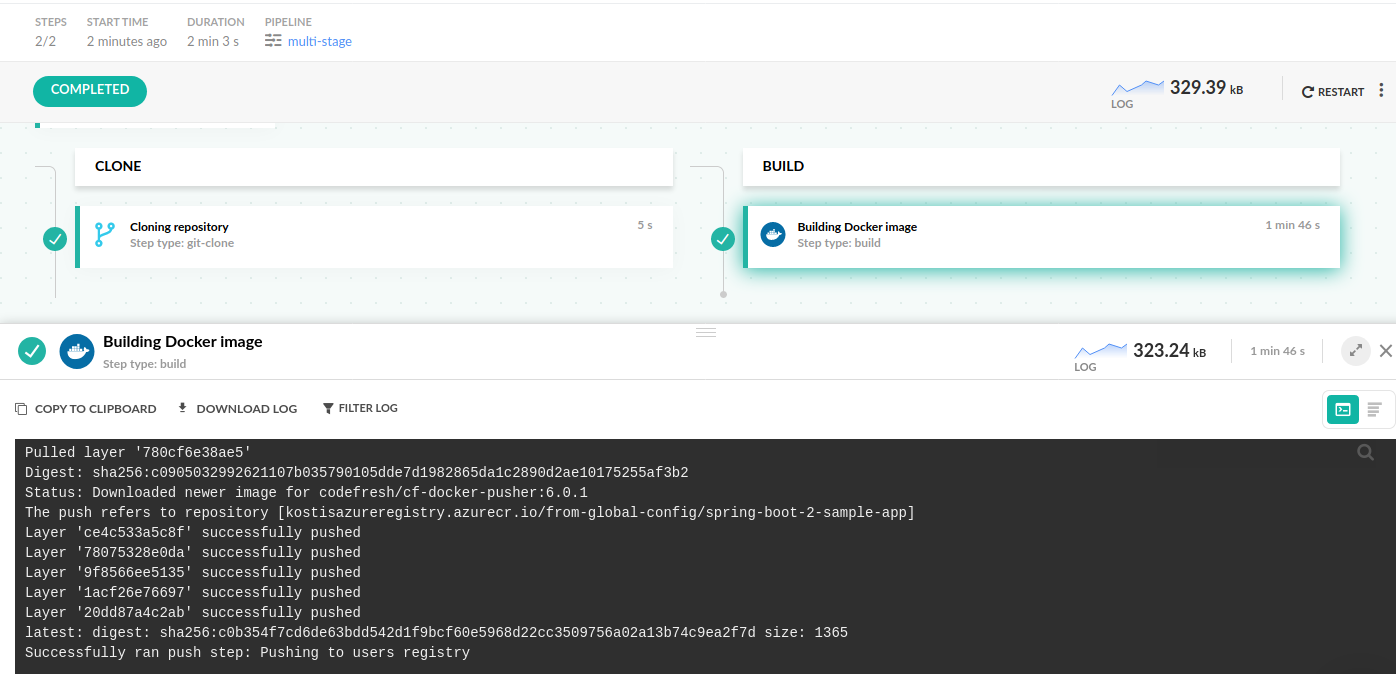Building Docker images
Create Docker images from Dockerfiles
Codefresh has first-class Docker build support. You can build Docker images in your pipeline in a declarative manner using the build step.
TIP
If your application is not deployed as a Docker image, see the basic compilation/packaging guide instead.
Building a Dockerfile in a pipeline works the same way as building the Dockerfile locally on your workstation.
Your Dockerfile should be valid, and follow all the best practices such as:
- Dockerfiles should be self-contained
- You should not have actions with side effects inside Dockerfiles
- You should have a proper
.dockerignorefile to minimize the Docker context size - Dockerfile directives should be placed according to best practices for caching
For more details, see also the Caching in pipelines. At the very least, you should understand and use Docker multistage builds (although Codefresh supports all kinds of Dockerfiles natively). Basically, if your Dockerfile is already optimized on your local workstation, it should also be optimized for Codefresh.
Codefresh uses the standard Docker daemon (or optionally Buildkit) behind the scenes, so if your Dockerfile has issues when you try to build it locally, it will have the same issues in a pipeline.
Docker packaging strategies
There are many ways to create a Dockerfile, and most organizations typically follow a different path depending on the type of application they package.
Brand-new applications are very easy to package into multistage Dockerfiles, while legacy/existing applications are adapted to dockerfiles that package an existing artifact.
We suggest spending some more time and creating multistage builds for all applications (even legacy ones).
Explaining all virtues of multistage Docker builds is outside the scope of this article but in summary, multistage builds:
- Are self-contained and self-describable
- Result in a very small Docker image
- Can be easily built by all project stakeholders, even non-developers
- Are very easy to understand and maintain
- Do not require a development environment, apart from the source code itself
- Can be packaged with very simple pipelines, not only in Codefresh, but in other CI systems as well
Multi-stage builds are also essential in organizations that employ multiple programming languages. The ease of building a Docker image by anyone without the need for JDK/Node/Python/etc. cannot be overstated.
Production-ready Docker images with multistage builds
If you have a multistage Dockerfile, then the respective pipeline in Codefresh is straightforward. You only need two pipeline steps:
- A clone step to check out the source code
- A build step to create the Docker image
For example, here is a Java dockerfile:
Dockerfile
FROM maven:3.5.2-jdk-8-alpine AS MAVEN_TOOL_CHAIN
COPY pom.xml /tmp/
RUN mvn -B dependency:go-offline -f /tmp/pom.xml -s /usr/share/maven/ref/settings-docker.xml
COPY src /tmp/src/
WORKDIR /tmp/
RUN mvn -B -s /usr/share/maven/ref/settings-docker.xml package
FROM java:8-jre-alpine
EXPOSE 8080
RUN mkdir /app
COPY --from=MAVEN_TOOL_CHAIN /tmp/target/*.jar /app/spring-boot-application.jar
ENTRYPOINT ["java","-Djava.security.egd=file:/dev/./urandom","-jar","/app/spring-boot-application.jar"]The Codefresh pipeline that builds this Dockerfile is the following:
codefresh.yml
version: '1.0'
stages:
- prepare
- build
steps:
main_clone:
title: Cloning main repository...
stage: prepare
type: git-clone
repo: 'codefresh-contrib/spring-boot-2-sample-app'
revision: master
git: github
build_app_image:
title: Building Docker Image
type: build
stage: build
image_name: spring-boot-2-sample-app
working_directory: ./
tag: 'multi-stage'
dockerfile: DockerfileThe beauty of this pipeline is that it is exactly the same for all multistage Dockerfiles regardless of the programming language that you use. So even if the Dockerfile was packaging a Node or Go application, the pipeline is oblivious to it.
You can find multistage build examples for other programming languages in the example section.
Creating self-contained Docker images
Even though multistage Dockerfiles are the optimal way to build Docker images, Codefresh still supports “plain” Dockerfiles which do not have multiple stages.
As an example, this Dockerfile for a Python application is created from a single parent image (although we use the slim variant to make the final image size smaller).
Dockerfile
FROM python:3.6-slim
ENV PYTHONDONTWRITEBYTECODE 1
ENV PYTHONUNBUFFERED 1
RUN mkdir /code
WORKDIR /code
RUN pip install --upgrade pip
COPY requirements.txt /code/
RUN pip install -r requirements.txt
COPY . /code/
EXPOSE 8000
CMD ["python", "manage.py", "runserver", "0.0.0.0:8000"]This Dockerfile can be built in the same way as a multistage one. We still need two pipeline steps, one to check out the code and another to build the Docker image.
codefresh.yml
version: '1.0'
stages:
- prepare
- build
steps:
main_clone:
title: Cloning main repository...
stage: prepare
type: git-clone
repo: 'codefreshdemo/cf-example-python-django'
revision: master
git: github
build_my_image:
title: Building Docker Image
stage: build
type: build
image_name: my-django-image
working_directory: ./
tag: master
dockerfile: DockerfileThe pipeline is similar to the previous one, so you can handle multistage and non-multistage builds in the same manner in Codefresh pipelines.
It is important however to note that the Dockerfile is still self-contained. It depends only on the source code of the application and all instructions needed to package the code are included in the Dockerfile itself.
Packaging existing artifacts in Docker images
An alternative way to create Docker images is to just package an existing artifact or application which is created earlier in the CI process.
NOTE
Though this is a very popular way to create Dockerfiles, and Codefresh supports it, we do NOT recommend writing Dockerfiles like this. Please learn about Docker multistage builds if you are not familiar with them.
You can see this pattern in all kinds of Dockerfiles that assume the application is already there (or that dependencies are already downloaded). Here is a Dockerfile that packages an existing JAR file.
Dockerfile
FROM java:8-jre-alpine
EXPOSE 8080
RUN mkdir /app
COPY target/*.jar /app/spring-boot-application.jar
ENTRYPOINT ["java","-Djava.security.egd=file:/dev/./urandom","-jar","/app/spring-boot-application.jar"]
HEALTHCHECK --interval=1m --timeout=3s CMD wget -q -T 3 -s http://localhost:8080/actuator/health/ || exit 1If you have Dockerfiles like this you need to enrich the basic pipeline shown in the previous sections and run a freestyle step that prepares the artifact BEFORE building the Docker image. Read more about freestyle steps in the basic CI process.
There are several disadvantages to these kinds of Dockerfiles:
- The Dockerfile is not self-contained anymore. You need to manually run some other command before actually running the Docker build
- A person who wants to build the Docker image on their workstation is also forced to have a full dev environment (e.g. the JDK or Node.js)
- The version of a development tool is specified twice (one in the Dockerfile and one in the CI/CD system)
Here is the Codefresh pipeline:
codefresh.yml
version: '1.0'
stages:
- prepare
- compile
- build
steps:
main_clone:
title: Cloning main repository...
stage: prepare
type: git-clone
repo: 'codefresh-contrib/spring-boot-2-sample-app'
revision: master
run_unit_tests:
title: Compile/Unit test
stage: compile
image: 'maven:3.5.2-jdk-8-alpine'
commands:
- mvn -Dmaven.repo.local=/codefresh/volume/m2_repository package
build_app_image:
title: Building Docker Image
type: build
stage: build
image_name: spring-boot-2-sample-app
working_directory: ./
tag: 'non-multi-stage'
dockerfile: Dockerfile.only-packageThis pipeline has an intermediate freestyle step that runs a specific version of Maven/JDK to create the JAR file. The JAR file is then available to the next step via the Codefresh volume.
In the example above, you can see that the version of JDK/JRE is mentioned twice (one in the pipeline and one in the Dockerfile). If developers decide to upgrade to Java 11, they need to change both places (and in big companies pipelines are usually managed by operators). If this was a multistage build then a developer could simply change just the Dockerfile and be certain that the pipeline is “upgraded” as well.
We find that similar workflows are from legacy CI solutions that are VM-based. Codefresh is a container-native solution, so if you have the opportunity you should create your pipelines from scratch when switching to Docker-based pipelines.
Avoiding non-standard Dockerfiles
We already established in the previous section that Dockerfiles should be self-contained. Another best practice is to make sure that all actions inside a Dockerfile are idempotent.
There are several Dockerfiles that attempt to mimic a CI/CD system and perform non-standard actions such as:
- Performing Git commits or other Git actions
- Cleaning up or tampering with database data
- Calling other external services with POST/PUT operations
Not only does this make the pipeline much more complex (because retrying the pipeline now has consequences), but you also need to pass special credentials in the Dockerfile itself via the pipeline, making the pipeline even more complicated.
You should avoid these kinds of directives inside a Dockerfile and simplify it so that all actions inside it are repeatable and non-destructive.
A Dockerfile should mainly:
- Clone extra source code (if needed)
- Download dependencies
- Compile/package code
- Process/Minify/Transform local resources
- Run scripts and edit files on the container filesystem only
As an example TO AVOID, this Dockerfile is also trying to run a SonarQube analysis
Dockerfile
FROM newtmitch/sonar-scanner AS sonar
COPY src src
RUN sonar-scanner
FROM node:11 AS build
WORKDIR /usr/src/app
COPY . .
RUN yarn install \
yarn run lint \
yarn run build \
yarn run generate-docsThis Dockerfile has the following issues:
- It can run only where a SonarQube installation is available
- It needs extra credentials for the SonarQube instance
- If the SonarQube installation has issues, then the application build will also fail
The proper way to build this Dockerfile is to make it package just the application:
Dockerfile
FROM node:11 AS build
WORKDIR /usr/src/app
COPY . .
RUN yarn install \
yarn run lint \
yarn run build \
yarn run generate-docsAnd then move the SonarQube part to the actual pipeline:
codefresh.yml
version: '1.0'
stages:
- prepare
- sonar
- build
steps:
main_clone:
title: Cloning main repository...
stage: prepare
type: git-clone
repo: 'my-github-repo/my-node-app'
revision: master
run_sonarqube:
title: Run SonarQube Analysis
stage: sonar
image: 'newtmitch/sonar-scanner'
environment:
- SONAR_TOKEN=my-sonar-token
commands:
- cd src
- sonar-scanner
build_app_image:
title: Building Docker Image
type: build
stage: build
image_name: my-node-image
working_directory: ./
tag: 'master'
dockerfile: DockerfileThis makes the Docker build step as simple as possible.
For more Docker best practices see our Docker anti-patterns blog post.
Pushing Docker images
The build step in Codefresh is very smart and automatically also pushes your Docker image to your default Docker registry.
Thus, if you run any of the above pipelines you can see the image created in the Docker image dashboard.
For more details on how to push Docker images see the working with Docker registries page.
Running Docker images
You can run Docker images inside a Codefresh pipeline using freestyle steps. You can use the freestyle step to run either an existing image from a private or public registry or even a Docker image that was created in the pipeline itself.
This is a very common pattern in Codefresh and works by simply mentioning the name of the build step that created the image.
codefresh.yml
version: '1.0'
steps:
main_clone:
title: Cloning main repository...
stage: prepare
type: git-clone
repo: 'my-github-repo/my-helper-project'
revision: master
my_testing_tools:
title: Building Docker Image
type: build
image_name: my-own-testing-framework
run_tests:
title: Running Unit tests
image: ${{my_testing_tools}}
commands:
- ./my-unit-tests.sh
For more details see dynamic build tools, and context variables
Related articles
How Codefresh pipelines work
Codefresh YAML for pipeline definitions
Steps in pipelines
Build step in pipelines




